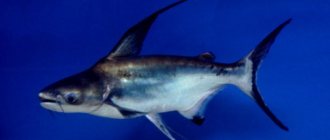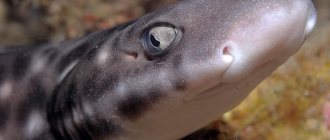You can make your aquarium interesting and unusual by populating it with beautiful plants and exotic fish. From the many varieties, it is worth choosing a decorative shark - it will definitely become a decoration for an artificial pond. The domestic shark is absolutely peaceful and gets along well with other aquarium inhabitants.
A similar shark can be kept in an aquarium
Decorative sharks in life and in the aquarium
Exotic predatory fish can inhabit not only coastal sea waters, but also the depths of the oceans. Just imagine: the length of the body of an aquarium shark can be no more than 20 centimeters, and can reach more than 1.5 m. Particularly large specimens are kept by aquarists with extensive experience, in specialized durable aquariums.
An amazing fact is the life expectancy of these fish. There are cases where a shark lived for 20 years in an artificial environment and felt great.
The decorative shark is very similar in appearance to its bloodthirsty relatives. However, these are fish with completely different behavior. She is quite peaceful, calm and does not pose a threat at all. On the contrary, miniature fish are stressed and may become afraid.
Aquarium sharks are not the bloodthirsty predators that are shown in films, but you should still not forget about safety measures.
There are several different domestic toothed predators adapted for life in an aquarium:
- pangasius (shark catfish),
- dwarf,
- feline
- horned.
Sharks require a large tank, preferably more than 400 liters. Do not get carried away by complex decor and intricate lighting of the aquarium. Fish do not need bright light, and complex compositions on the bottom can cause injury. Pay great attention to the issue of aeration and water filtration - your fish need a clean habitat.
Monitor your temperature and diet. The water in the tank should be between 28-30 degrees. The fish's diet should include all kinds of seafood: shrimp, cod fillet, squid, and various shellfish. Both starvation and overeating of fish should not be allowed!
Reproduction
You can also get offspring from aquarium sharks in an unnatural environment. In order for the female to begin laying eggs, a number of conditions are necessary for this:
- Foods containing silicon;
- Vitamin supplementation;
- Content of iodine ions in a water tank.
When keeping sharks, it is important to use vegetation to a minimum
The subtleties of keeping exotic sharks from professionals
Keeping aquarium predators is unproblematic and simple. You should approach the purchase of this fish responsibly and think through the following questions in detail:
- What type of mini sharks to buy for your home.
- What volume of aquarium is suitable for fish to keep them comfortable?
- What decorations, filters and compressors to choose.
Even a novice aquarist can create ideal living conditions by strictly following the order and relying on knowledge.
Aquarium: volume and shape
For proper maintenance, the volume of water for sharks requires at least 400 liters. Otherwise, the fish will not be able to fully move, and therefore develop. Round tanks or hexagon-shaped aquariums are ideal in shape. As decoration, place small pebbles or flat stones on the bottom.
A shark needs a large aquarium in which it can swim in a circle.
Water
Correctly selected water will be a comfortable habitat for sharks. Normally it should be around 28-30 C°. In a cool environment, fish catch colds and become seriously ill. It is preferable to prepare water of medium hardness. A neutral or slightly alkaline environment is ideal for a predator.
Feeding
The shark feeds on seafood. The diet should include shrimp, fresh or frozen squid and lean fish. Young individuals will happily eat ground fish products. For mature predators, it is enough to cut everything into small pieces.
Cat - up to 100 cm
A shark with an interesting name and no less interesting appearance settles in shallow water, where it feeds on crustaceans and fry. The shark got its name for a reason - it has light-sensitive sensors (which are located near its charming and unusual eyes), with the help of which it senses electrical signals emanating from another living creature.
The color of the shark is gray-charcoal, with dark spots along the body. Her body is quite slender and really flexible, like a cat's. On average, the shark is 75 cm long and weighs 1.5 kg. Of course, compared to large sharks, the catfish is very small, so some even keep it in aquariums.
Brief information about decorative aquarium sharks
Among the huge variety of predatory fish, there are obvious giants that can be dangerous to humans if not kept correctly, and there are small exotic specimens, the maintenance of which is adapted to domestic conditions.
False shark (pangasius)
Pangasius or shark catfish, it is also called a false shark. In Southeast Asia, pangasius has been farmed as a commercial fish for hundreds of years; in the wild, it grows up to one and a half meters long. In the aquarium, the maximum recorded size of a false shark is 100 cm, and its age is 20 years.
Shark baloo is a freshwater fish from the barb family that is very similar to sharks, but requires minimal care.
Dwarf shark
Often the body of such a shark reaches a length of only 25 cm. It has quite sharp teeth. The pygmy shark is ideal for an aquarium due to its small size and nature. The fins and belly of the fish glow. The fish lives in the waters of the Indian and Pacific Oceans.
cat shark
The maximum size can reach 1-1.5 meters in length. Needs a huge volume of water: 1000-1500 liters. Sometimes miniature representatives of the family are also found on sale.
Horned shark
It reaches a length of 100-115 cm. Above the eyes there are ridges that resemble horns.
Each shark is endowed with its own character and behavioral characteristics. Decorative aquarium sharks are not only a decoration for your aquarium, but also your favorite pets.
Breeding
It is almost impossible to distinguish young individuals by gender. The shark reaches sexual maturity at the age of four years, while the freshwater female is lighter in color and much more massive than the male. Breeding aquarium fish at home is problematic and almost impossible. In Asia, shark catfish farming is done in lakes or water containers.
In the natural environment, adult fish go to spawn from July to November, moving upstream, spawning in underwater thickets, laying up to 100 thousand eggs. The fry appear after 2–4 days, after which Pangasianodon hypophthalmus return to their usual environment.
Real shark or Pangasius
Children and adults are very surprised when they learn from a pet store seller that a harmless sea monster is swimming peacefully in an aquarium, and its almost complete copy is a harmless catfish. Pangasius is a beautiful large fish, belongs to the shark catfish family. You can visually identify an aquarium shark from a real predator by its characteristic color and body shape. Young representatives have a bluish or ash color. Bright silvery stripes are clearly visible on the sides of catfishes. Despite the fact that the fish are almost identical, you can recognize a peace-loving catfish by the following characteristics:
- flattened head shape,
- outstanding eye shape and large mouth,
- four mustaches,
- fringe on the anal fin,
- The fin on the back is set upward.
The external differences between pangasius and a real shark are clearly visible in the photo.
The catfish has a certain similarity with a predator in its dynamic swimming style. In a flock they actively scour in search of food and love to swim in circles.
There are 3 types of fish most often found in artificial habitats:
- High-finned pangasius.
- Siamese pangasius.
- Small Pangasius.
An adult shark catfish reaches an average length of 60 cm.
Compatibility with other fish
Aquarium sharks, in principle, are peace-loving fish, so they can get along well with other inhabitants of the “underwater kingdom.” The main thing is not to allow the fish to starve, since the predatory instinct may manifest itself in relation to other representatives living in the aquarium.
It is not recommended to put different types of sharks in the same tank, as they will have strong differences in care and maintenance.
A home aquarium with mini sharks is a truly delightful sight; you just have to follow the basic rules for caring for these miniature predators, and they will delight you with their mesmerizing beauty for a long time!
Secrets of keeping Pangasius from professionals
Pangasius is a demanding and somewhat capricious false shark, so it is not suitable as a first fish for beginners and young aquarists. Those who are a little familiar with exotic fish or are willing to invest money in proper care may want to take a closer look at this species.
Choosing an aquarium
Fish grow quickly and can reach their maximum size in a short time. Therefore, when buying an aquarium, choose the largest capacity and capacity possible.
Pangasius is a schooling fish and it is recommended to have a school of at least 2-3 fish. Otherwise, being alone can lead to severe stress, illness and slow decline!
For a small family of 3 catfish, an aquarium volume of more than 600 liters is desirable. Choose roomy and wide models so that the fish feel comfortable and can move freely through a long space.
Few people know that this type of fish is very prone to jumping. Be sure to take this feature into account before choosing an aquarium model. Choose models with lids or custom ones with durable glass.
Smooth pebbles are suitable for decoration. Pay attention also to pebbles and all types of low-growing plants. Be sure to leave free space in the aquarium for the safety of the catfish. Complex decorative elements can cause injury and bruise.
Aquarium location
Pangasius is very susceptible to stress and fright , so place the aquarium with fish in quiet places where there will be no sudden screams, claps, or other unexpected situations.
When frightened, the catfish loses its bearings and rushes chaotically around space, hitting corners and objects. In addition, a sensitive fish may even faint from fear.
Nutrition
Pangasius feeds not like an ordinary catfish, but while afloat. This large fish will not sink to the bottom to feed, and will definitely not eat up any leftover food. If you notice aggressive and nervous behavior, attacks on neighbors, this means that Pangasius is hungry. Perhaps he simply does not eat enough during feeding. Treat your freshwater friend to special food, fish, chopped squid or shrimp.
00:36
Feeding pangasius
02:43
➤ Harm to pangasius fish ➤
Keeping it clean
By consuming a lot of food and especially meat, fish pollute the water with excretions from waste products. Therefore, it is important to install modern filter and compressor systems in the aquarium. Pangasius will get sick and wither before our eyes from contaminated water. Weekly it is necessary to replace up to 40% of the water in the aquarium with fresh water.
Choice of neighbors
The choice of neighbors for shark catfish must be approached with all responsibility. Suitable for an aquarium with still small sharks:
- barbs,
- angelfish,
- guppy,
- goldfish.
As soon as mini sharks begin to mature and grow, they already regard their miniature neighbors as prey and a tasty lunch. As they grow older, add other large and energetic fish to the catfish. Excellent companions for adult Pangasius will be:
- citron cichlazomas,
- parrots,
- astronotuses,
- other types of Asian fish.
I strongly recommend not keeping pangasius with small and leisurely fish. The small fish will be swallowed or injured by the awkward movements of the large catfish.
Breeding
These fish do not reproduce in a home aquarium.
Shark catfish diseases
The first causes of shark disease are due to poor care, improper feeding and non-compliance with water standards or the size of the aquarium. Before you begin treating fish, it is necessary to correctly diagnose the disease and identify the causes of its occurrence.
The most common diseases:
- Pangasius in an aquarium can often damage itself by hitting the walls or being damaged by decorative objects. Subsequently, ulcers may appear on the skin of the decorative shark; the wound must be treated with potassium permanganate or brilliant green.
- In case of poisoning, treatment will be fasting or a protein diet.
- Oxygen starvation. Pangasius aquarium is located at the surface of the water, the catfish often swallows air. Urgently increase aeration, reduce temperatures, increase flow rate using a filter.
- Fin rot. Fin rot is most often caused by bacteria or a bite from another fish.
- Dropsy or bloating. Improve nutrition and water quality.
- Ichthyophthiriasis or white spots - bad water.
- Fungal disease or fish mold is white growths that look like mold. Dirty water.
Dwarf lantern - up to 18 cm
The oceans and seas of our planet are inhabited by various interesting creatures - some of them are formidable predators, others are overly touching, and others are very ridiculous, like the Luna fish. the dwarf lantern shark belong to ? We leave this up to your discretion.
This baby is so small that it fits in your hand - the shark grows up to 18 cm in length. It lives in tropical and temperate waters of the Atlantic, Pacific and Indian oceans at depths of up to 10,000 meters.
Like all lantern sharks, it has luminous areas on its belly and fins - the fish uses them for camouflage at shallow depths, and at greater depths for hunting.
Black two-color - up to 50 cm
The black bicolor shark can perhaps be called the most beautiful inhabitant of the home tank. She has a black-velvet body and a bright tail, which stands out effectively against the background of her body.
Aquarists, wanting to see this fish in their aquarium, are ready to forgive its character - the black shark is very aggressive and has a complex disposition. For this reason, it is undesirable to add other fish to it - most likely, conflict will not be avoided. With proper care, the black shark grows up to 50 cm in length.
Blackfin - up to 15 cm
It is not surprising that visitors to aquariums spend most of their time watching sharks - these frightening and beautiful predators instantly attract attention.
You can enjoy sharks (albeit small ones) at home if you set up an aquarium for them. Some people enjoy keeping miniature sharks. The blackfin shark (also known as the “ Malagasy night ”) shark is always in motion - to breathe it requires constant circulation of water through the gills, because the fish does not have gill covers.
Distributed in the Indo-Pacific. Shark skin is like sandpaper, so contact with it can cause extensive, deep damage to the skin. The blackfin shark lives for about 30 years, growing up to 15 cm in length.
7 3
Dwarf spiny - up to 16 cm
The dwarf spiny shark is found in all oceans of the planet except the Arctic. Males do not exceed 15 cm in length, and females can grow a little more - up to 20 cm.
The dwarf shark has an elongated, spindle-shaped body, a pointed nose and a long muzzle. Has bright big eyes. This baby feeds on various bottom fish, which, of course, are even smaller than itself. According to observations, the spiny shark descends to a depth of 200-500 m to catch prey.
Dwarf cat - up to 19 cm
Cat sharks (also known as " ribbon cat sharks ") have several subspecies. These babies inhabit the Indian Ocean and the South China Sea. They are especially numerous off the coast of India and the Philippines. Prefers to stay near the bottom.
Externally, the shark has a slender and narrow body, it has a small and rounded head and characteristic large eyes. One of the smallest sharks, when grown, does not exceed 19 cm, but we are talking about females, males are even smaller - they have a body length of up to 16 cm. The food for the dwarf shark is even smaller bottom inhabitants - fry.











